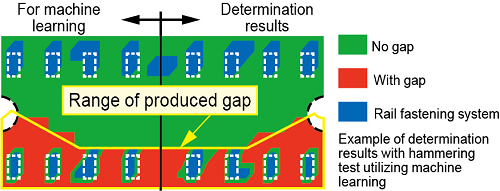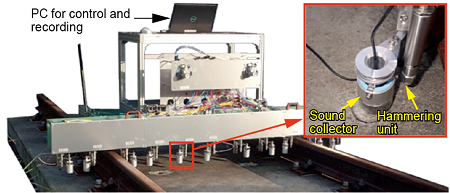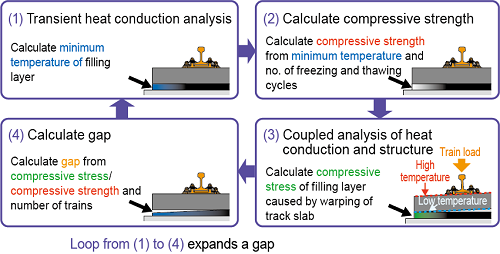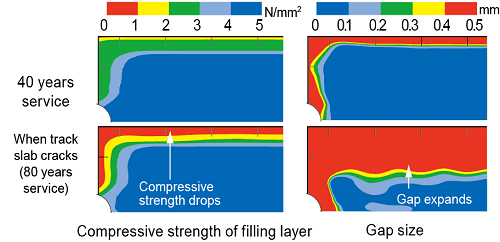5. Inspection of gaps by hammering slab track filling layers and prediction of deterioration
In cold regions, frost damage tends to reduce the compressive strength of the filling layers of slab tracks. Train loads can also cause gaps between the track slab and filling layer.
To quantitatively and efficiently detect the extent of such gaps, we proposed a method of detection that combines a hammering test and machine learning.
Application of this method to slab tracks confirmed that gaps can be detected with 90% accuracy (Fig. 1).
To inspect a large number of track slabs in a short time, we developed a continuous hammering test device with 11 hammering units (Fig. 2).
This device makes it possible to inspect a single track slab in approximately five minutes.
When intensive repairs are conducted to extend the service life of slab track in cold regions, it is necessary to predict deterioration of filling layers in order to select which areas of the laid slab track will require repairs.
Through experiments, we confirmed that the compressive strength of filling layers decreases with the number of freezing and thawing cycles and that the amount of plastic deformation due to repeated loading increases as the ratio of compressive stress to compressive strength increases.
Through a coupling of unsteady heat conduction analysis and structural analysis, we identified a mechanism by which the compressive stress and the amount of plastic deformation at the outside of a filling layer increases when a track slab is subjected to train loads under upward convex warping caused by rising temperatures during the day (Fig. 3).
Based on these findings, we developed a method for predicting deterioration capable of determining the loss of strength in a filling layer and the gap between track slab and filling layer (Fig. 4).
Other Contents
- 1. Earthquake early warning method for the earthquake source fault regions
- 2. Design method for bearing parts to control damage and improve restorability
- 3. Method for verifying the restorability of railway structures considering small-and medium-scale earthquakes
- 4. Method for evaluating vehicle safety in strong winds using probabilistic risk assessment
- 5. Inspection of gaps by hammering slab track filling layers and prediction of deterioration
- 6. Method for estimating snow accretion and snow dropping of a train vehicle for investigating countermeasures against snow dropping
- 7. Method of applying image processing-based object detection and obstacle determination to safety applications
- 8. Support system for preventing a decline in alertness level of drivers
- 9. Phased array ultrasonic testing method for easy detection of flaws in bogie frame welds
- 10. Oil for axle-box for Shinkansen with excellent low-temperature performance and maintainability
- 11. Seat surfaces for minimizing injuries to passengers in the event of a collision
- 1. Earthquake early warning method for the earthquake source fault regions
- 2. Design method for bearing parts to control damage and improve restorability
- 3. Method for verifying the restorability of railway structures considering small-and medium-scale earthquakes
- 4. Method for evaluating vehicle safety in strong winds using probabilistic risk assessment
- 5. Inspection of gaps by hammering slab track filling layers and prediction of deterioration
- 6. Method for estimating snow accretion and snow dropping of a train vehicle for investigating countermeasures against snow dropping
- 7. Method of applying image processing-based object detection and obstacle determination to safety applications
- 8. Support system for preventing a decline in alertness level of drivers
- 9. Phased array ultrasonic testing method for easy detection of flaws in bogie frame welds
- 10. Oil for axle-box for Shinkansen with excellent low-temperature performance and maintainability
- 11. Seat surfaces for minimizing injuries to passengers in the event of a collision




